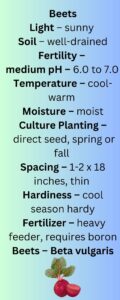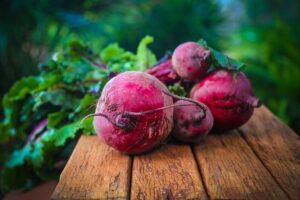Discover the joy of home gardening with our comprehensive guide on how to grow beets! Learn about their cultivation, harvest, storage, and preservation for a year-round supply of sweet, homegrown beets.
Overview of Growing Beets
Beets are an extremely versatile and nutritious vegetable that is easy to cultivate in home gardens, both for beginners and experienced growers alike. Beets come in a variety of shapes, sizes, colors, and textures, making them great additions to any culinary repertoire. In addition to their nutritional value, beets have also been found to possess numerous health benefits such as reducing inflammation, lowering cholesterol, and aiding in digestion. In this article, you will learn how to grow beets.
To ensure a successful harvest, growers need to understand all aspects of beet cultivation, including soil preparation, planting techniques, proper care and maintenance, harvesting methods, and post-harvest storage tips. With the right knowledge and effort put into their growth process, beets can yield an abundance of nutritious vegetables that are not only delicious but beneficial to one’s health.
Soil Preparation for Beets
To prepare your soil for beet cultivation, start by clearing the area of any weeds or other debris. Next, work compost or well-rotted manure into the soil to improve its fertility and structure.
Choosing the Right Soil Type for Beets
Beets thrive in well-draining, loamy soil. However, they can adapt to a variety of soil types, including sandy and clay-rich soils. It’s important to avoid heavy, water-logged soils as they can impede root growth and lead to diseases.
Enhancing Soil Fertility
Incorporating organic matter into your soil can greatly enhance its fertility. Organic matter like compost or well-rotted manure not only provides essential nutrients for the beet plants but also improves soil structure and water-holding capacity.
Soil pH Adjustment
Beets prefer a slightly acidic to neutral pH level, between 6.0 and 7.0. If your soil’s pH is outside this range, you can adjust it by adding lime (to raise pH) or sulfur (to lower pH). Always perform a soil test before making any pH adjustments to avoid harming your plants.
When to Plant Beets
Plant your beet seeds as soon as the soil can be worked in the spring. Beet plants tolerate frost well and even improve in flavor after a frost. In milder climates, you can also plant a fall crop of beets, sowing the seeds in late summer.
Various Cultivars of Beets
There are numerous cultivars of beets to choose from, depending on your taste and growing conditions. Some popular cultivars include ‘Detroit Dark Red’ with its deep red roots and sweet flavor, ‘Golden’ boasting a golden-yellow color and mild taste, and ‘Chioggia’ known for its candy-cane-like red and white rings.
Planting Depth and Spacing for Beets
Sow beet seeds about 1/2 inch deep in the soil. Space the seeds about 1 to 2 inches apart in rows 12 to 18 inches apart. After the seedlings emerge, thin them to stand about 3 to 4 inches apart. Proper spacing allows adequate room for the beetroot to grow and prevents overcrowding.
Tips for Sowing Beet Seeds
Keep the soil consistently moist until the seeds germinate. Cover the soil lightly with straw or mulch to retain moisture and control weeds. Since beet seeds are actually clusters of seeds, you will likely need to thin the seedlings once they develop their first true leaves.
Watering Regimen for Beets
Beets require a consistent watering schedule to ensure steady, uninterrupted growth. Aim to water your beet plants about 1 inch per week, taking rainfall into account. Avoid overwatering which can lead to root rot; the soil should be moist, not waterlogged.
Weeding and Mulching Beets
Weeding is crucial in the early stages of growth when beets are establishing themselves. Regularly remove weeds that can compete with your beet plants for nutrients. Mulching around the beet plants will not only help retain soil moisture but also suppress weed growth. Organic mulches such as straw or compost are excellent choices.
Disease and Pest Prevention of Beets
Keeping your beet plants healthy is the best way to prevent disease. Practice crop rotation and avoid planting beets in the same spot year after year to prevent soil-borne diseases. Common pests include leaf miners and flea beetles; use row covers to protect young plants. If you notice leaf spots or wilting, apply an organic fungicide and ensure the plants have good air circulation to prevent fungal diseases.
Companion Planting with Beets
Companion planting is an excellent strategy for maximizing your garden’s yield and maintaining the health of your crops. Beets are highly versatile and grow well with many vegetables. Here are a few companions for beets:
- Cabbage Family: This includes cabbage, broccoli, cauliflower, and Brussels sprouts. These plants have similar watering and sun needs to beets but do not compete for nutrients as they draw from a different level in the soil.
- Lettuce: Lettuce has shallow roots and therefore doesn’t compete with beets for space or nutrients. They also appreciate the same cool conditions.
- Onions: Onions can help deter some pests that affect beets, and they both appreciate fertile, well-drained soil.
- Radishes: Radishes grow and mature quickly, making them an excellent companion for slower-growing beets. They can be harvested before the beets need more space to grow.
Avoid planting beets near pole beans or mustards, as these plants can inhibit beet growth. Understanding the companion planting strategy can significantly contribute to a bountiful harvest.
Harvesting Beets
Beets are usually ready for harvest when they are about the size of a golf ball, typically 50 to 70 days after planting for most varieties. However, they can be harvested at any size that seems desirable. If you can’t see the beet’s size because it’s underground, gently brush away some soil around the top of the beet. Another indicator is the color of the beet greens. When they become a vibrant, rich green color, it’s usually time to start checking the beetroot’s size.
When it’s time to harvest, carefully dig around the sides of the beet and lift it from the ground. Avoid pulling directly on the plant’s stalks as this can damage the beetroot.
Storing and Preserving Fresh Beets
Once harvested, cut off the greens leaving about 1 to 2 inches of the stem attached. Do not wash the beets before storing; instead, brush off any loose dirt. Store them in a cool, humid location such as a refrigerator. They can be kept for up to 2-3 weeks.
For long-term storage, beets can be pickled, canned, or frozen. To freeze, first, blanch the beets in boiling water for about 30 seconds, then transfer to an ice bath to stop the cooking process. Once cooled, peel them, cut into slices or cubes, and freeze them in a single layer on a baking sheet. Once frozen, transfer the beet pieces to a freezer-safe bag or container. They will keep for up to a year when frozen.
You can also can, pickle or ferment your beets.
Conclusion:

Beets are a great addition to any garden, and there’s nothing quite like the satisfaction of harvesting your own freshly grown beets. With proper cultivation and harvesting techniques, you can enjoy fresh beets from your garden year-round. Whether you choose to eat them raw or cooked, pickled or frozen, home-grown beets offer a sweetness that store-bought beets cannot match. So get out there and start planting your delicious homegrown beets! Happy gardening!
For more on growing vegetables click here.
For info on how to ferment your beets click here.
If broccoli is more to your taste than beets, read my article on how to grow broccoli here.
Resource: https://search.uada.edu/s/search.html?collection=uaex-search&query=growing+beets

